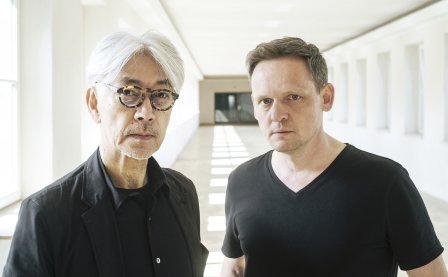Christened after the concert hall where the piece was recorded, Sala Santa Cecilia is a sparkling 19-minutes of improvised musical dialogue between the highly respected laptop-wizard Christian Fennesz and the prolific electronic musician and Yellow Magic Orchestra founder Ryuichi Sakamoto. But before we talk about the music, some hagiography. Saint Cecilia lived in pre-Christian Rome and is praised for retaining her chastity and faith despite being betrothed to a pagan husband. She claimed to have her own "private" angel who watched over her virginity and body, and, after her husband's conversion, was able to introduce and share this angel with him. Committed to death for her faith, she is said to have survived three ax blows to the neck before dying a Martyr after three days of preaching. Sometime along the ages, she garnered the title of patron saint of music. Coincidently, this piece was commissioned by Rome, now very much Christian, for 2004's Romaeuropa festival just about the same date of Cecilia's annual feast on November 22nd.
Opening with filtered drones and organs, this piece progresses from somewhat strident beeps to warm and scintillating flutters, traversing varied peaks and troughs throughout its scant life. After reaching a high of lush chords and percussive, distorted tones, the piece ends with a long and careful fade, allowing you to descend slowly and securely back to earth after frolicking amongst the heavens. Enough characteristic sounds emerge out the radiant haze to distinguish Sakamoto's blanketing synth from Fennesz's oscillating twitters, but the piece is better served by simply basking in its state of sonic beatitude. There is a sort of venerableness to Sala Santa Cecilia, and when the glorious day arrives when we all worship online, I imagine music like this will replace the organ (Cecilia's instrument of choice) in supporting hymns and sermons praising the lives of the electronic saints. When that time arrives, look out for the images of these two gentlemen hunched over their keyboards in a Cubist collage of stained glass along the walls of the chapel. Such a short length leaves you wanting more, and thankfully a full-length release is planned for the future. Take this news as a message from the mount, as Saint Cecilia has certainly smiled on this collaboration.
Christened after the concert hall where the piece was recorded, Sala Santa Cecilia is a sparkling 19-minutes of improvised musical dialogue between the highly respected laptop-wizard Christian Fennesz and the prolific electronic musician and Yellow Magic Orchestra founder Ryuichi Sakamoto. But before we talk about the music, some hagiography. Saint Cecilia lived in pre-Christian Rome and is praised for retaining her chastity and faith despite being betrothed to a pagan husband. She claimed to have her own "private" angel who watched over her virginity and body, and, after her husband's conversion, was able to introduce and share this angel with him. Committed to death for her faith, she is said to have survived three ax blows to the neck before dying a Martyr after three days of preaching. Sometime along the ages, she garnered the title of patron saint of music. Coincidently, this piece was commissioned by Rome, now very much Christian, for 2004's Romaeuropa festival just about
the same date of Cecilia's annual feast on November 22nd.
Opening with filtered drones and organs, this piece progresses from somewhat strident beeps to warm and scintillating flutters, traversing varied peaks and troughs throughout its scant life. After reaching a high of lush chords and percussive, distorted tones, the piece ends with a long and careful fade, allowing you to descend slowly and securely back to earth after frolicking amongst the heavens. Enough characteristic sounds emerge out the radiant haze to distinguish Sakamoto's blanketing synth from Fennesz's oscillating twitters, but the piece is better served by simply basking in its state of sonic beatitude. There is a sort of venerableness to Sala Santa Cecilia, and when the glorious day arrives when we all worship online, I imagine music like this will replace the organ (Cecilia's instrument of choice) in supporting hymns and sermons praising the lives of the electronic saints. When that time arrives, look out for the images of these two gentlemen hunched over their
keyboards in a Cubist collage of stained glass along the walls of the chapel. Such a short length leaves you wanting more, and thankfully a full-length release is planned for the future. Take this news as a message from the mount, as Saint Cecilia has certainly smiled on this collaboration.
1. Sala Santa Cecilia
More about: Ryuichi Sakamoto




